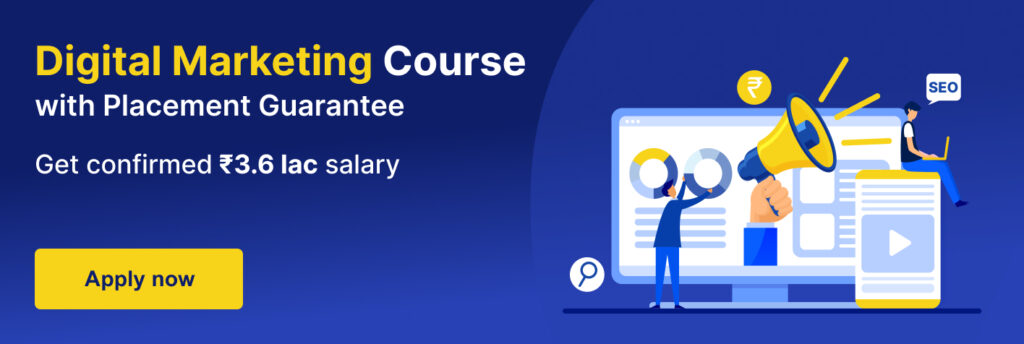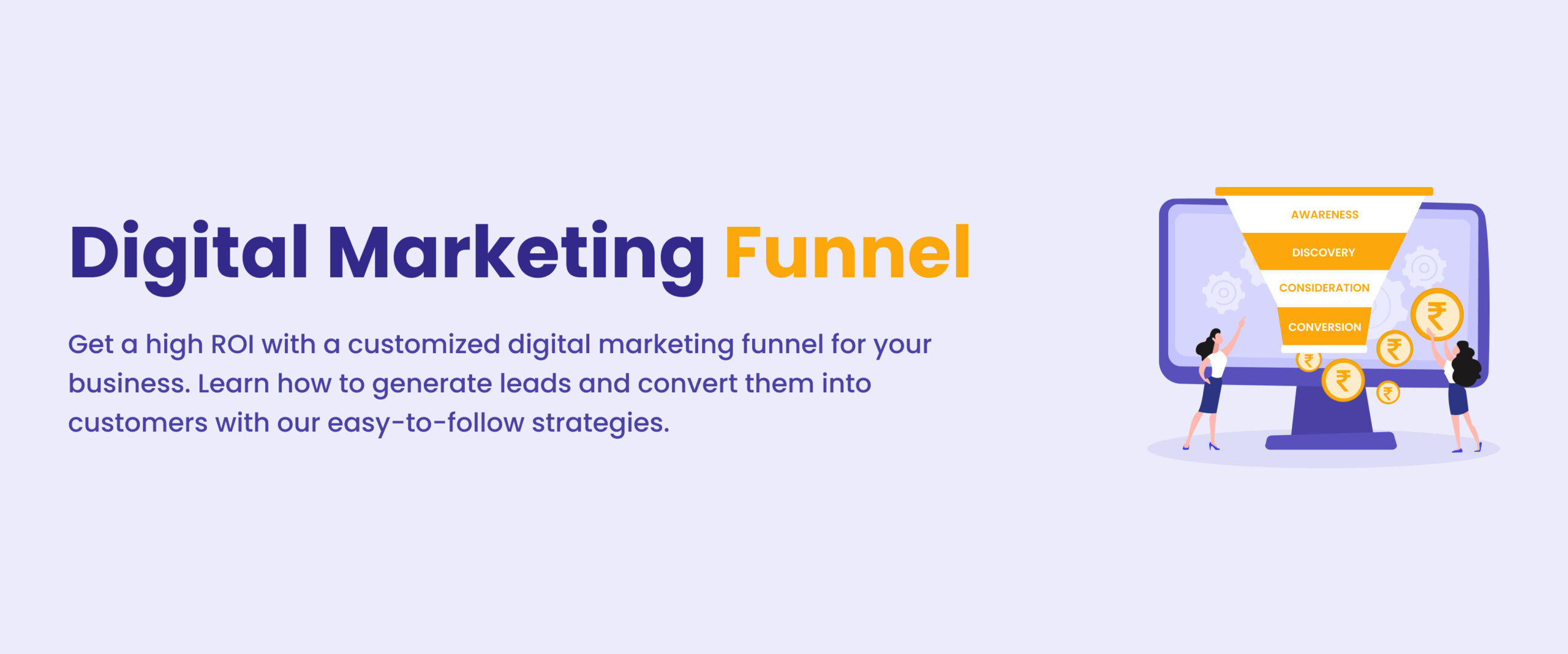Digital Marketing Funnel: A Comprehensive Guide
A funnel is like a big digital sieve. You start at the top with a wide range of potential customers, and as you move down, they funnel through different stages until you end up with your most dedicated customers at the bottom. It helps marketers separate out the people who are most interested in their product or service from the rest of the crowd and then guide them smoothly through the sales process.
With a funnel, marketers can maximize their conversions and increase their revenue. A dedicated digital marketing funnel is a great way to take your business to the next level. This blog will take you through the details of understanding funnel marketing.
Understanding the Digital Marketing Funnel
A funnel gives a visual representation of the customer journey. It is an effective marketing strategy that allows businesses to capture leads and convert them from mere website visitors to customers. It helps businesses guide their potential customers through the buying process. Every brand uses at least one funnel-building approach. In a marketing funnel, a customer primarily engages with digital content and online marketing materials. Some examples are blog posts, video clips, e-books, and more.
Good and effective marketing and sales funnels together create success for any brand or business. The difference between these funnels is at what point “who” interacts with the customer. Once a lead has passed through the marketing funnel, the sales funnel takes over, focusing on more personal interactions. You may consider taking an online digital marketing training course to boost your skills in this field.
Important Components of the Digital Marketing Funnel
It consists of three key components: the foundation, the floodgate, and the actual sales funnel.
- The Foundation: It involves understanding the target audience, their preferences, and their online search patterns. This information helps companies craft unique marketing strategies that appeal to potential customers throughout their buying journey.
- The Floodgate: It refers to the traffic sources that send visitors to the funnel, such as SEO, social media marketing, paid ads, content marketing, and cold outreach via email marketing.
- The Actual Sales Funnel: This funnel directs traffic to the company’s website, involving a lead magnet, an amplifier that highlights the brand as a superior choice, and an online conversion event where the user converts into a lead.
Different Types of Funnels in Digital Marketing
The various funnel types used in digital marketing include:
1. Hourglass Funnel
The hourglass model stands out as the most well-known digital marketing funnel. This funnel has four main parts:
- Awareness: The awareness part, at the top like in an hourglass, aims to get lots of people interested in the product and service.
- Engagement and Conversion: In the middle, there’s engagement and conversion, where you find those who are interested and ready to buy the product or service.
- Retention: This is the bottom part of the hourglass funnel. The goal is to keep loyal customers happy and have a sustained, long-term relationship with them.
2. Looping Funnel
This kind of funnel is also called a loyalty loop. This is because the goal here is to keep satisfied customers, retain them, and turn them into loyal customers. The basic idea behind the looping funnel is that it’s easier and cheaper to keep your existing customer base than it is to acquire new ones. To make this loop work, a business strategy must have a good plan to stay in touch with current customers and get them to love the brand.
This loop funnel has five steps:
- Step 1: Make people aware of your brand.
- Step 2: Help them think about buying your stuff.
- Step 3: Get them to make a purchase.
- Step 4: Keep them as loyal customers.
- Step 5: Turn them into fans who tell others about your brand.


3. Micro-Moments Funnel
The goal of the Micro-Moments Digital Marketing Funnel is to create an immersive experience for users so they are more likely to consider your product or service. This funnel also uses targeted content to create a more personalized user experience, which helps drive conversions.
This funnel has four implementation steps:
- Step 1: Attracting traffic to your website with targeted content.
- Step 2: Capturing user attention with personalized messages.
- Step 3: Engaging prospects with interactive content.
- Step 4: Converting leads with personalized offers.
4. Click Funnel
Unlike traditional marketing customer interaction mediums, the click funnel is a more streamlined and quick funnel strategy. Leads will click through the funnel rather than have multiple interactions at different points in time.
An example of a click funnel might look like this:
- Ad: A user sees an ad, such as on social media or through a search engine, and clicks on it if the ad interests them.
- Landing Page: Upon clicking on an ad, the user is directed to a landing page that offers additional information about the product or service, which ultimately leads to a conversion page.
- Call to action: The user is directed to a specific action, such as signing up for a list or accessing an offer or deal, where they can either make a purchase or contact a seller.
5. Content Marketing Funnel
Content marketing is a type of marketing funnel that involves creating and sharing content such as blogs, videos, and social media posts to reach and engage potential customers.
- The goal of content marketing is to attract potential customers to your website and convert them into leads.
- The content marketing funnel involves creating content that is tailored to each stage of the customer journey, from the initial discovery of your brand to the final purchase and beyond.
- Content should be optimized for each stage of the funnel to ensure that potential customers have the information they need to make an informed decision about your product or service.
6. Conversion Funnel
A conversion funnel in digital marketing is the path that customers take from the initial discovery of a brand to making a purchase. The ultimate goal of a conversion funnel is to convert visitors into customers.
This type of funnel activity will involve creating content that is designed to generate informative customer awareness and drive purchases. The content should be persuasive and highlight the benefits of the product or service.
7. Purchase/Buying Funnel
Designing this funnel activity will involve enticing the user to make a purchase. This funnel includes steps to guide the customer through the purchase process, such as providing a checkout page or displaying an order form. After the purchase is completed, the customer should have the option to sign up for a newsletter or other promotional offers.
Digital Marketing Funnel Stages and Implementation Strategies
There are six stages to designing a marketing funnel, which are as follows:
1. Exposure and Awareness:
The first step in building a digital marketing funnel is to get the brand or company the right attention. Advertising and promotion of the products or services must be done on the appropriate digital platforms. At this stage, the sole purpose of the seller is to attract customers.
Statista estimates that by 2025, around 4.5 billion people will be using social media platforms. Therefore, it increases the business’s need to have a strong presence on social media and search engines.
To strengthen the digital presence, start with a content marketing strategy with search engine optimization (SEO) techniques or paid advertisements. The goal is to produce content that captures user’s attention, such as educational videos and infographics, and attracts as much traffic as possible. You can also make use of long-tail and medium-tail keywords in your content.
2. Identification and Consideration of Audience
In this phase of the digital marketing funnel, companies need to listen to what customers are thinking and deliver the right content to win them over. Here, we are talking about customers who think a lot before making a purchase. To convince such customers, the content should explain the benefits of the product and its efficiency.
Some of the ways to understand the mindset and preferences of the customers are: introducing FAQs and surveys, investing in case studies can help clarify issues and confirm the necessity of the product in customers’ lives, etc.
The following approaches can help implement this stage of the funnel:
- SEO: It is crucial for companies to appear on the first page of search engines and attract customers. More reviews can contribute to a better ranking.
- Video Marketing: It is important for customers, as they prefer watching videos over reading about products.
- Pay-per-click (PPC): This is also a crucial approach, as users prefer the top three ads in search engine results. Not working on PPC may lead to the loss of potential customers.
- Email Marketing: It is a professional way to reach customers by presenting product details, ease of use, and the solution offered. Ultimately, the goal is to convince customers of the effectiveness of the service offered by the products.
3. Conversion and Purchase
At this stage of the funnel, the customer is convinced that the product is good and is about to make a purchase. Strategies to implement this stage include using targeted and personalized messaging, offering incentives such as discounts or free shipping, providing detailed product information, and using social proof such as customer reviews or testimonials. It can also include retargeting campaigns to remind customers of their products and encourage them to complete the purchase.
4. Customer Relationship
The customer relationship stage in the digital marketing funnel is focused on creating long-term relationships with customers. Strategies to implement this stage include providing customer support, offering loyalty programs, introducing referral programs, and creating personalized content for customers. Businesses can use customer feedback to improve their products and services and develop better customer relationships.
5. Retention
The retention stage in the digital marketing funnel refers to the point where a customer has already made a purchase and is now encouraged to make further purchases. To achieve this, businesses can implement strategies such as loyalty programs, personalized discounts, and targeted emails. Offering incentives for referrals, providing excellent customer support, and creating engaging content that encourages customers to return to engage with the brand are all effective tactics.
Learn about Digital marketing funnel in detail in our digital marketing course with placement.
How To Create a Digital Marketing Funnel?
Creating a digital marketing funnel involves understanding the different stages of the customer journey, from the initial discovery of your brand to the final purchase and beyond. Your marketing funnel should include steps to attract potential customers, convert them into leads, and nurture them until they become customers.
Here’s how a marketing funnel can be created:
- Define the Marketing Goal: The first step in creating a marketing funnel is to define the business’s marketing objectives and goals to make the right marketing decisions and take action.
- Structure the Funnel: According to the different stages of the digital marketing funnel, creating a visual image of the stages is crucial. This is because it is easier to know what the best model for your business is.
- Attract Traffic to Your Digital Funnel: With your funnel established, it’s time to understand what you need to do to generate the expected traffic at each stage. Consider the following ways in which you can achieve this.
- Careful Consideration of the Target Audience: This is the second essential step towards building a marketing funnel. For sustained visitor and buyer engagement, look closely at the digital behavior of visitors and customers to produce the right digital marketing content that meets their preferences and needs.
- Gather the Statistics: What is a marketing strategy without careful consideration and analysis of data? Use digital marketing toolkits like Semrush to gather data and insights into customer behavior and tailor the content for the marketing funnel accordingly.
- Seek Feedback: It is good to have an automated system for post-purchase follow-up, such as sending emails to customers with offers or asking them to leave reviews of their experience.
Importance of Creating a Digital Marketing Funnel
Creating a marketing funnel is pivotal for a brand and business because of the following reasons.
- Segmentation of Marketing Activities: A funnel helps you improve and segment how you target your marketing efforts. This means you can create content, ads, and strategies that are more useful to your audience as they go through the buying process. As a consequence, a brand/business becomes more efficient in segmenting communication channels and activities to interact with customers.
- Better Lead Generation: By segmenting marketing efforts to improve a customer’s experience with your brand or business, it is simpler to make lead generation effective and turn leads into customers.
- Increased Relevance of the Brand/Business: When a brand/business correctly implements a marketing funnel with the right digital content at the right time, its relationship with customers or potential buyers becomes more relevant to the decision to buy.
- Create Relevant Marketing Campaigns: It provides a structured marketing approach that can help create more effective campaigns. This enables businesses to tailor content, ads, and strategies to the specific needs of their customers at different stages of the buying process.
- Increases Productivity: It allows for a better understanding of the customer’s journey, which can help increase the productivity of teams and ensure that the right content is delivered at the right time.
Conclusion
A digital marketing funnel is a way of systematically strategizing your brand’s exposure across online platforms. By segmenting your marketing efforts, creating relevant campaigns, and tailoring content to the customer’s needs, you can ensure that the marketing funnel is working efficiently and delivering the right content at the right time. Take the first step today and start developing a unique marketing funnel to maximize your brand/business’s success.







